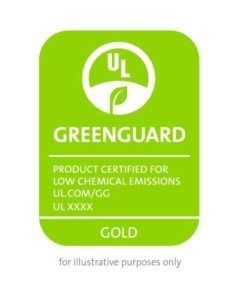Indoor Air Quality Now Certified by UL
 The Underwriters Laboratories, better known as simply UL, is a global safety consulting and certification company. Founded in 1894. They are headquartered in Northbrook, Illinois, with offices in 46 countries around the world. Perhaps best known for safety certification of electric appliances and components (at least here in the US), as of 2011, UL diversified into indoor air quality standards, by acquiring GEI.The Greenguard Environmental Institute, or GEI, is an industry-independent, third-party, non-profit organization and offers three product certification programs and one building certification program. The Greenguard Environmental Institute was established by Air Quality Sciences, Inc, which is an indoor air quality firm, in June 2001. Greenguard Certification is recognized and accepted by sustainable building programs and in building codes worldwide.If a product has been GREENGUARD Certified, it has been tested and scientifically proven to have low chemical emissions, says Scott Steady, product manager for indoor air quality at UL Environment. In other words, it’s guaranteed to give off only low levels of volatile organic compounds, or VOCs.Indoor Air Dirtier Than Outdoor AirVOCs are carbon-based chemicals (such as formaldehyde) that easily become vapors or gases. Mattresses, flooring and even wall paints give off VOCs. They’re responsible for that new building smell and new car smell, Steady says. Inside your house, you may be breathing anywhere from 50 to hundreds of different VOCs at any time.The air indoors is two to five times more polluted than outside air, Greenguard.org says. What's dirtying up that air? Airborne chemicals from furniture and building materials and mold. Poor ventilation just adds to the problem.When a product bears Greenguard certification it means that it is designed for indoor spaces in such a way that it meets strict chemical emissions limits and has been tested for more than 10,000 chemicals, Greenguard says. These products have the backing of this third-party organization based on empirical scientific data. The idea is to produce healthier interiors free from harmful emissions. Companies that have Greenguard certification can claim greater credibility when they make sustainability claims.The Greenguard Indoor Air Quality Certification Program identifies low-emitting materials, finishes, and products for indoor environments.If sustainability has become a key feature of your market, it would be wise to look for the Greenguard Certification on as many products as possible.Looking for more new design trends, tips, and ideas? Get in touch with TD Fall today.
The Underwriters Laboratories, better known as simply UL, is a global safety consulting and certification company. Founded in 1894. They are headquartered in Northbrook, Illinois, with offices in 46 countries around the world. Perhaps best known for safety certification of electric appliances and components (at least here in the US), as of 2011, UL diversified into indoor air quality standards, by acquiring GEI.The Greenguard Environmental Institute, or GEI, is an industry-independent, third-party, non-profit organization and offers three product certification programs and one building certification program. The Greenguard Environmental Institute was established by Air Quality Sciences, Inc, which is an indoor air quality firm, in June 2001. Greenguard Certification is recognized and accepted by sustainable building programs and in building codes worldwide.If a product has been GREENGUARD Certified, it has been tested and scientifically proven to have low chemical emissions, says Scott Steady, product manager for indoor air quality at UL Environment. In other words, it’s guaranteed to give off only low levels of volatile organic compounds, or VOCs.Indoor Air Dirtier Than Outdoor AirVOCs are carbon-based chemicals (such as formaldehyde) that easily become vapors or gases. Mattresses, flooring and even wall paints give off VOCs. They’re responsible for that new building smell and new car smell, Steady says. Inside your house, you may be breathing anywhere from 50 to hundreds of different VOCs at any time.The air indoors is two to five times more polluted than outside air, Greenguard.org says. What's dirtying up that air? Airborne chemicals from furniture and building materials and mold. Poor ventilation just adds to the problem.When a product bears Greenguard certification it means that it is designed for indoor spaces in such a way that it meets strict chemical emissions limits and has been tested for more than 10,000 chemicals, Greenguard says. These products have the backing of this third-party organization based on empirical scientific data. The idea is to produce healthier interiors free from harmful emissions. Companies that have Greenguard certification can claim greater credibility when they make sustainability claims.The Greenguard Indoor Air Quality Certification Program identifies low-emitting materials, finishes, and products for indoor environments.If sustainability has become a key feature of your market, it would be wise to look for the Greenguard Certification on as many products as possible.Looking for more new design trends, tips, and ideas? Get in touch with TD Fall today.
